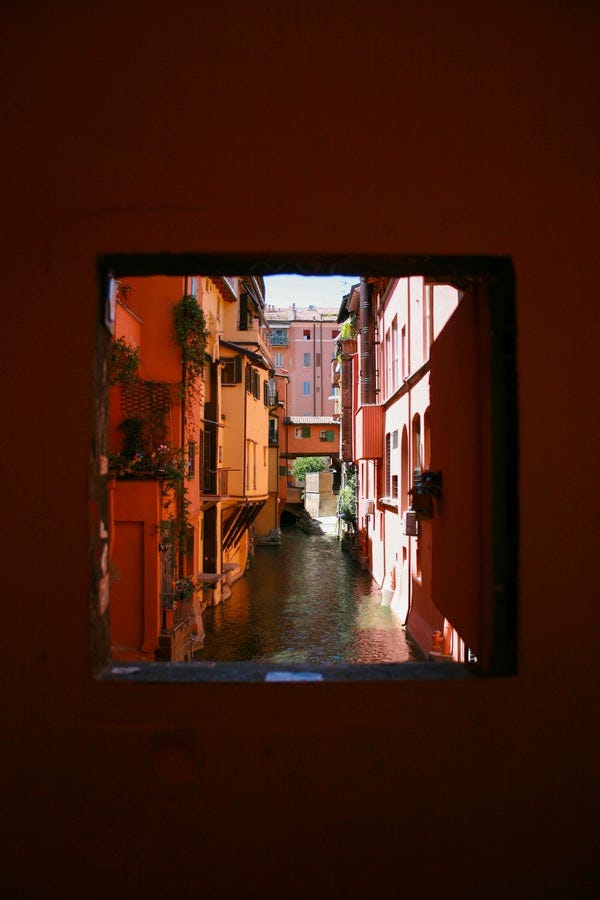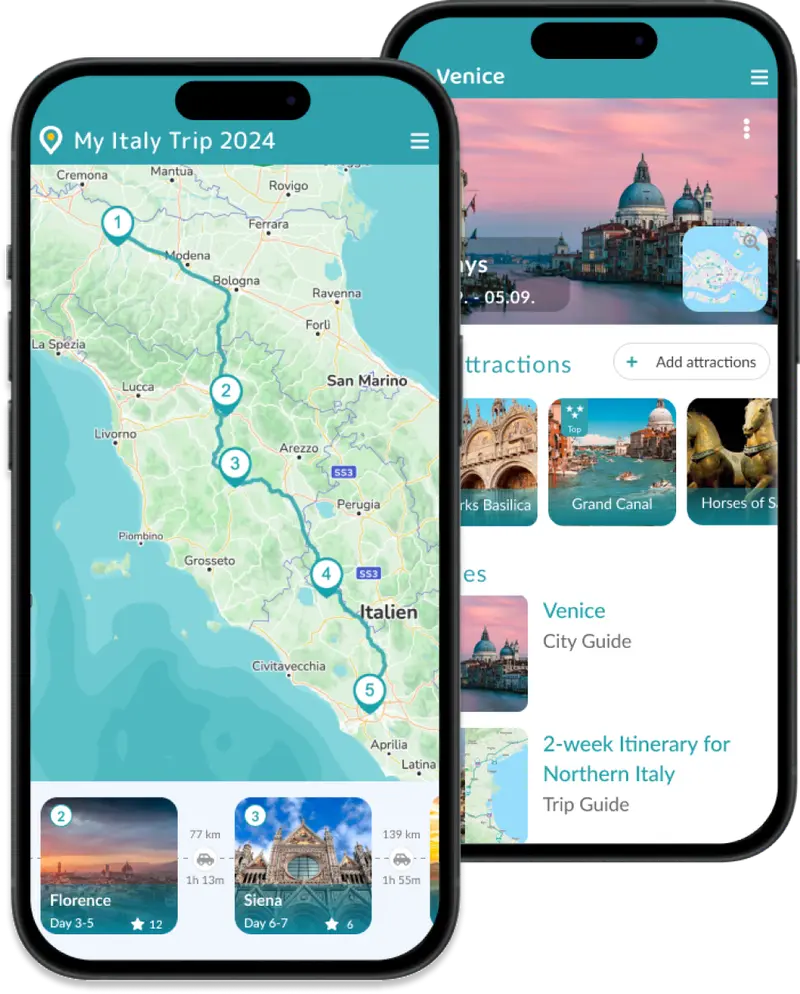The vibrant student city of Bologna has well earned its three nicknames. Known as "la Dotta" for its prestigious university, "la Grassa" for its culinary scene, and "la Rossa" for its charming red-hued terracotta buildings, Bologna invites you to a visit.
Bologna, the capital of Emilia-Romagna, has deep-rooted ties to academia, art, and gastronomy. As a testament to its medieval legacy, Bologna boasts the oldest university in the Western world, where illustrious scholars like Dante Alighieri once walked its ancient corridors.
Top Highlights of Bologna










Inspiration
Travel Information
How long should you stay?
We recommend you to stay 2 - 4 days in Bologna. With two days you have enough time to appreciate Bologna's attractions, as well as its gastronomic scene.
With four days you also have time for some day trips to explore the Emilia-Romagna region.
Best time to visit Bologna
You can visit Bologna year round, since there are also a lot of indoor activities during winter.
Spring (March - May)
The pleasant weather makes spring an attractive time to visit, but it's essential to book accommodations in advance. The temperatures are mild (5-20°C), the botanical garden is in full bloom and there are a few food and wine festivals. During May, visit the Di Verde Festival or the Wild Asparagus Festival.
Fall (Sept-Oct)
Autumn is a great time to visit due to the mild weather (12-25°C), food festivals, and thinner crowds. Great for culinary experiences and cultural events, such as the TartuFesta, which celebrates truffles.
Summer (June-Aug)
Summer is hot with average temperatures of 20-30°C with high humidity. Enjoy the outdoor film festival at the Piazza Maggiore or the Lambrusco Festival (held in June).
Winter (Dec-Feb)
Italy's Gastro City is even in winter a good destination for a weekend trip. Temperatures range between 10 to -1°C, but with the festive atmosphere, the hearty food to warm up and 50 museums to step into, you have a perfect budget trip at hand.
How to get to Bologna?
Located in the heart of northern Italy, Bologna is a major transportation hub and easily reachable by (high speed) train, car, plane or bus.
By Plane
The Guglielmo Marconi Airport is located approximately 10 km from the city center. The airport offers numerous daily flights from italian and international destinations.
How to get to Bologna's centre?
- The Marconi Express monorail directly connects the airport to the central railway station in just about 7 minutes, with a fare of €13 for a one-way trip (2024).
- The Airport Shuttle Line 944 runs every 20min and also connects the airport to the city, reaching as far as the nearby Ospedale Maggiore.
- Bus line 81/91 provides a cheap connection for €6. The bus station is at Birra, a 20-minute walk from the airport.
- Taxis are readily available, with the 20-minute journey costing about €25.
By Train
Bologna Centrale is a major railway hub with frequent services linking to major Italian cities like Milan, Rome, and Florence. With the high speed trains it takes only 30 minutes from Florence, 1 hour from Milan, 90 minutes to Venice, and 2 ½ hours to Rome.
By Car
Bologna is one of Italy's major motorway junctions, connecting the north and south of the country via the A1, A13, and A14 highways. It's about an hour's drive from Florence (A1) and slightly over two hours from Milan (A1). The A13 connects Bologna with the Veneto Region with cities like Padua, Venice and Padua. The A14 runs along the Adria from Romagna down to Taranto.
As usual in Italy, the city center is a ZTL zone, meaning you have to be careful you don't drive there by accident. You don't want to be fined! Should you have a parking lot at your hotel within the ZTL-Zone, your hotel will arrange a pass to reach them. (Ask them about it.) Without hotel parking, it's best to leave the car in one of the parking garages.
Fancy a roadtrip?
Be inspired by our hand-picked road trips.
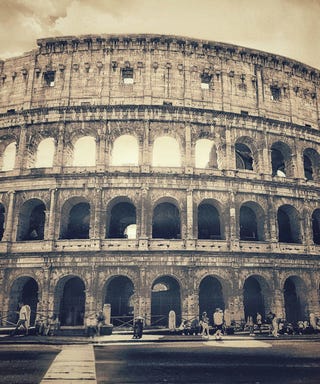
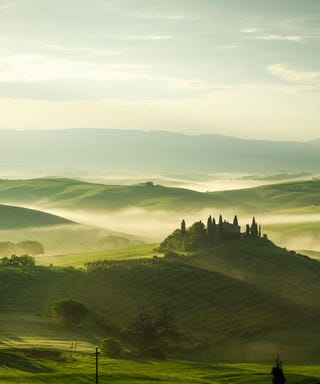

Day Trips from Bologna
Rocchetta Mattei: A unique Castle Experience
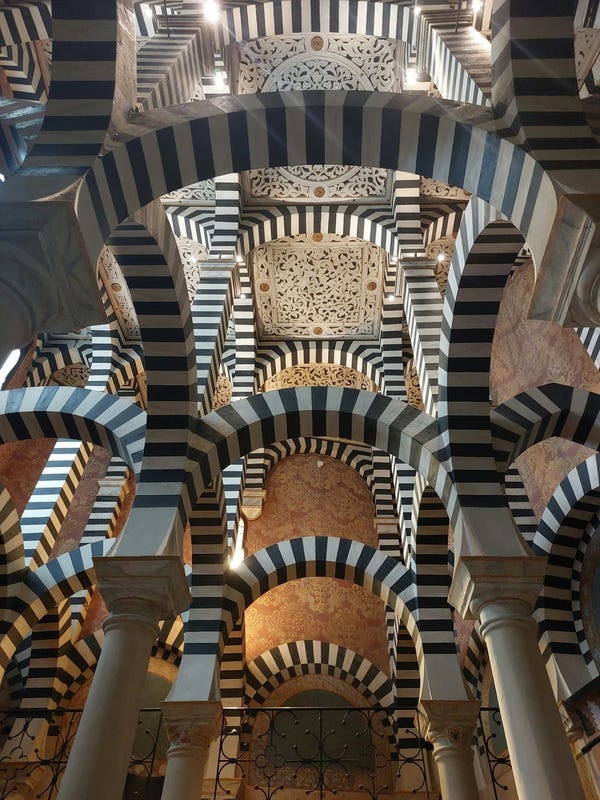
Important Note: Book your tickets best weeks in advance, as visits are restricted to weekends and require a mandatory 1-hour guided tour.
How to get there: It is actually possible to come by train from Bologna Centrale (to Riola), followed by a one-kilometer walk. However, travelling by car is much more convenient, especially in the summer heat.
Culinary Specialties
Aperetivo
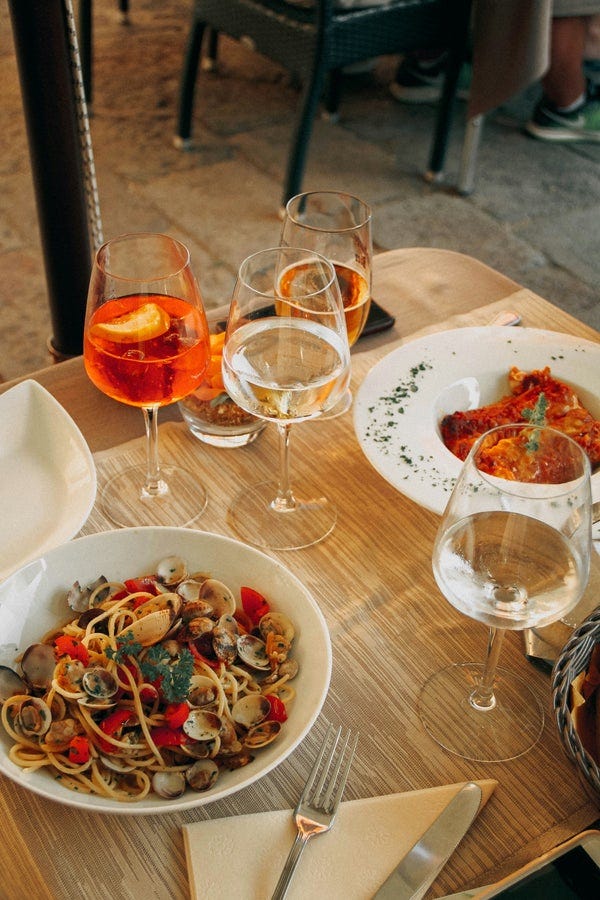
Cocktail warning: Given Bologna's status as a student city, numerous bars cater to students. Avoid the cheap cocktails, light on alcohol content, and go for the good stuff!
Local Wines you must try in Bologna
- Undoubtedly the king of Bolognese wines, Pignoletto offers a refreshing experience whether enjoyed as a white, light yellow wine or as an aperitif. Its profile is dry, delicately fruity, and mildly acidic.
- Another distinctive local white wine, Alionza, showcases the uniqueness of an indigenous grape variety.
- Rosso Bologna: For red wine enthusiasts, Rosso Bologna, made with a minimum of 50% Cabernet Sauvignon grapes, promises a ruby red color and an intense, pleasant flavor. This wine, as well as the Reno Wine is also produced in the vineyards right outside the city.
- Lambrusco: Originating from the vineyards near Modena, Lambrusco is a red, slightly frizzy wine celebrated for its versatility, pairing well with both rich and light dishes. It's crucial to distinguish between the traditional Lambrusco — dry, fruity, and refreshing, sealed with a cork stopper — and the mass-produced export version, a blander, sweetened version found in screw-capped bottles. Lambrusco is synonymous with around 60 grape varieties, however the Lambrusco Salamino and Lambrusco Grasparossa are the most commonly used ones. With diverse Lambrusco appellations such as Lambrusco Reggiano DOC and Lambrusco di Sorbara DOC, which contains up to 40% Salamino grapes, the wine is celebrated for its diverse variations. Lambrusco Grasparossa di Castelvetro DOC stands out for its richness and dryness.
- Negrettino: A lesser-known grape variety producing a noteworthy local red wine.
A Bit of History: The roots of winegrowing in the Emilia-Romagna region trace back to the Etruscan era. In the Middle Ages, vines such as Lambrusco, Sangiovese, and Pignatello gained national importance, solidifying the region's rich viticultural heritage. Since the 19th century, international varieties like Cabernet Sauvignon, Merlot, Chardonnay, and Sauvignon Blanc have contributed to the region's diverse wine offerings.
What to Eat
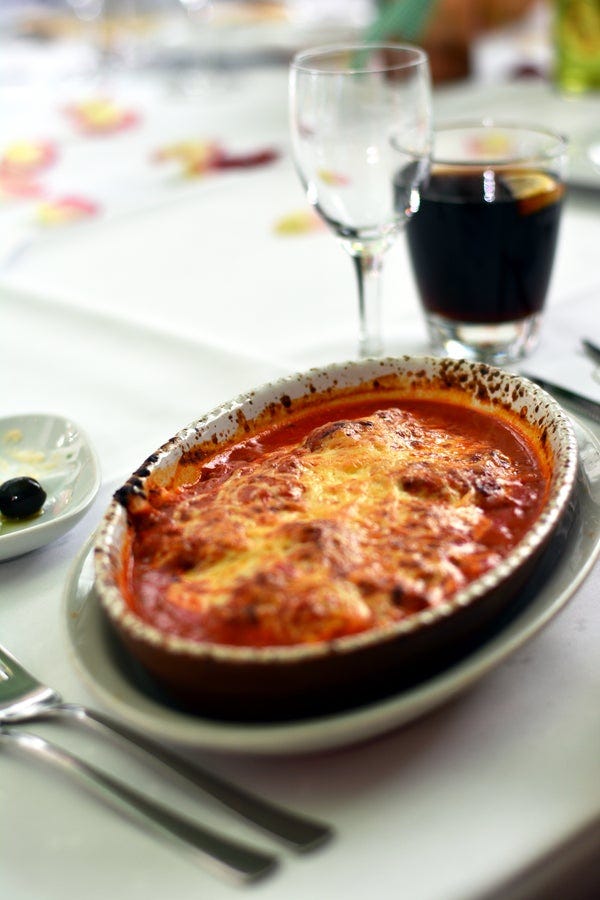
- Ragù alla Bolognese: The national dish of Italy has been invented in the late 18th century by Alberto Alvisi, a chef of Pope Pius VII. This meat sauce includes beef, pork, ripe tomatoes, wine, nutmeg, and seasonings and is traditionally served with pasta.
- Tagliatelle al ragù alla Bolognese: Originating from Bologna, this rich pasta dish features tagliatelle and a savory ragù of minced beef and pork, tomatoes, and spices. Typically served with fettuccine or pappardelle.
- Lasagne alla Bolognese: A symbol of Sunday meals and family gatherings in Emilia-Romagna, this dish is made of layers of homemade pasta sheets, ragù alla Bolognese, and béchamel sauce, baked to perfection.
- Mortadella Bologna: The delicious Mortadella can be traced back to the Etruscan era, when the area was rich in oak forests and local swine. The traditional sausage is made from pork, which is mashed into a fine paste, with cubes of fat and mixed with spices.
- Tortellini in Brodo: This is one of the most typical dishes in Bologna. The tortellini filled with pork loin, prosciutto, mortadella, Parmigiano Reggiano, and nutmeg are served in a golden capon broth.
- Balanzoni: Another traditional pasta dish from Bologna, the green tortellini-like pasta is filled with ricotta, spinach, Parmigiano Reggiano, and chopped mortadella or pork loin. It is served with a butter and sage sauce.
- Amarena Cherry: Developed by Gennaro Fabbri, these dark cherries have a sour, acidic, and sweet flavor. They are commonly used in cocktails, cakes, pies, pastries.
- Gramigna con Salsiccia: A local favourite from Bologna, this dish features curly-shaped pasta with a simple sausage ragù made from pork, and tomatoes. Best top this simple yet delicious dish with freshly grated Parmigiano Reggiano cheese and pair it best with the Sangiovese di Romagna wine.
- Crescentina: A type of puffed bread from the Emilia Romagna region, Crescentina is typically served hot with fresh soft cheeses and cold cuts or with jam. The name of this dish varies by city: gnocco fritto in Modena, pinzino in Ferrara, torta fritta in Parma, chisulen in Piacenza
- Certosino: This sweet bread with origins in Bologna is a traditional treat enjoyed in the region. It's usually served at Christmas and contains almonds, pine nuts, cocoa powder, dark chocolate, honey, and candied fruit.
- Friggione: A traditional peasant dish originating from the villages around Bologna, Friggione is an onion and tomato dip. It is prepared by macerating thinly sliced white onions in salt and sugar, then slowly cooking them in lard.
- Fave dei morti (“cookies of the dead”): This traditional dessert is made for All Saints’ Day. It is a multi-coloured almond paste cookie.
Shopping
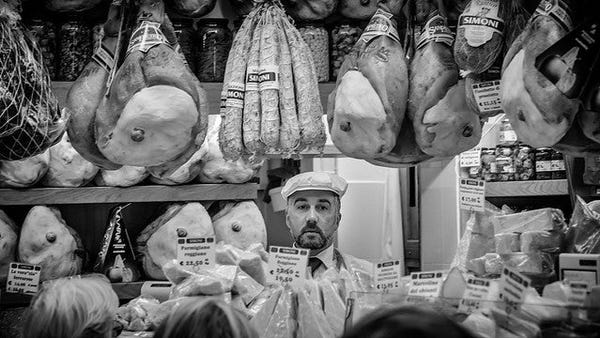
- Stroll through the Quadrilatero district and visit the , known for its local top cuisine. The market is great for picking up treats like Parmigiano to take home (Via Clavature, 12).
- Experience the vibrant atmosphere of the , an indoor market and food court, located at Via Ugo Bassi 25.
- is home to cafes, high-end shops, fashion boutiques, and souvenir stands. Very nice.
- Interested in international fashion? Head to Via Rizzoli, Bologna's leading shopping street. Here you can also watch street performances.
- Via Indipendenza is a charming pedestrian zone and also houses famous attractions like the Teatro Arena del Sol and the . Under the beautiful arcades, you will find fashion stores and souvenir shops.
Fun Facts about Bologna
- Bologna boasts three unique nicknames: The Red (Rossa), the Fat (Grassa), and the Learned One (Dotta).
- It is the proud home of the oldest university in Europe, founded in 1088.
- The Maserati logo: The artist behind the brand logo drew inspiration from Neptune's trident and the red and blue hues of Bologna's banner.
The Naughty Secret of Neptune
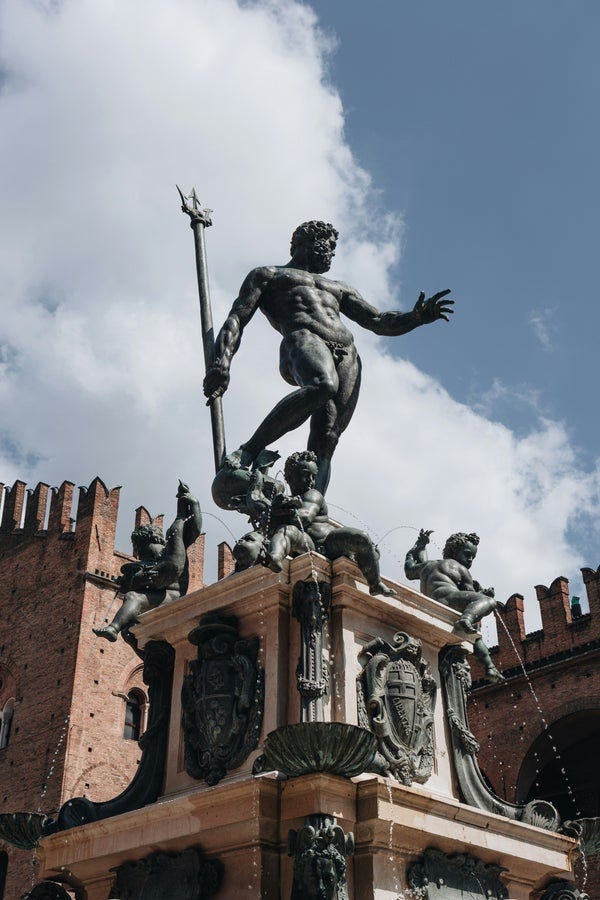
Curious? Go to the Piazza Maggiore, stand on the black stone found near the steps of (stone of shame), and see for yourself!
Whispering Walls
In the archway of the you can whisper to the wall and be heard at the opposite diagonal corner as clear as day. This architectural feature was intentionally designed during the Middle Ages to allow lepers and people with plague to confess their sins to their priests from afar. According to legend also secret lovers used this to exchange messages without being discovered.
To try it yourself, go to to the the archway, speak into one corner facing the wall and have your friend face the wall in the corner diagonal from you. Have fun!
The Three Arrows and the Naked Wife
Direct your gaze upward to the roof of Corte Degli Isolani, where three embedded arrows tell two intriguing legends of how they came to be there. According to one legend, a merchant, upon discovering his wife with another man, hired assassins to kill her. However, they were so captivated by her nudity that they missed their mark. Alternatively, another tale suggests that thieves attempting to rob a nobleman were similarly distracted by the presence of a naked wife.
Superstitious Students
Bologna's students avoid climbing to the top of the , and they never walk across the middle of the Piazza Maggiore. If they did, the students believe they wouldn't graduate.
Hidden Window to Bologna's Little Venice
